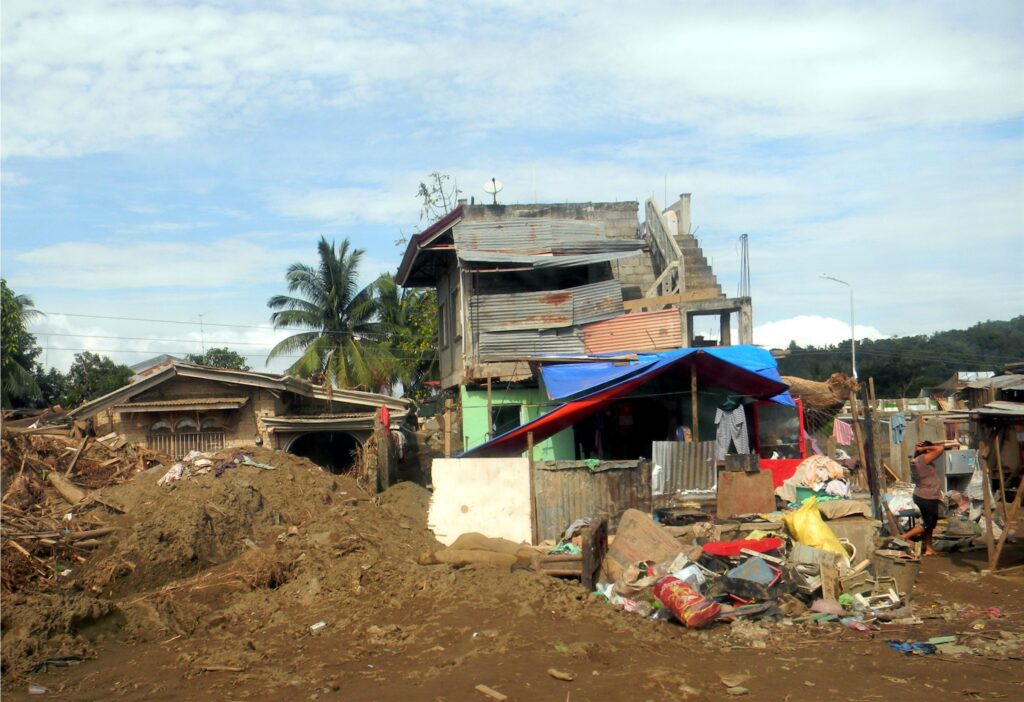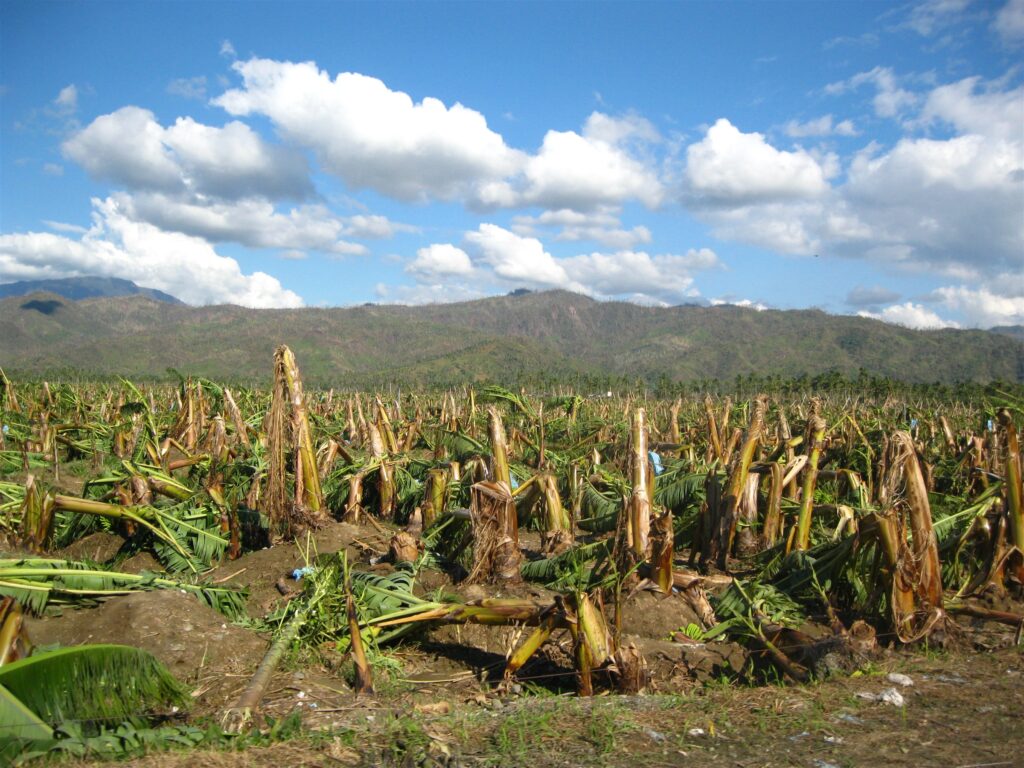Text by Henrylito D. Tacio
Photos by Darrell Blatchley
First, it was Pablo. Then, Yolanda came along. And most recently, it was Odette. These three are names of devastating typhoons that hit the Philippines in recent years.
Pablo (international name: Bopha) struck the Philippines on December 4, 2012. Rushing floodwaters destroyed some entire barangays and killed some 1,901 people. “Entire families may have been washed away,” commented then-Interior Secretary Mar Roxas.
With winds of 280 kilometers per hour, Pablo was the strongest tropical cyclone on record to ever hit the southern Philippines, particularly Davao de Oro and Davao Oriental. The storm caused widespread destruction, leaving thousands of people homeless.
Yolanda (Haiyan), which made its landfall on November 8, 2013, was one of the strongest storms ever recorded, with wind speeds of more than 300 kilometers per hour and storm surges of over four meters.
Described as “the most intense tropical cyclone worldwide in 2013,” Yolanda killed at least 6,300 people. It severely affected more than 170 cities and municipalities in 14 provinces across six regions found within a 100-kilometer storm track.
Odette (Rai) entered the Philippine Area of Responsibility (PAR) on the night of December 14. The strong storm pounded the country the following day. Wikipedia reports: “Heavy rainfall, strong and gusty winds impacted several areas around the storm’s path. Many areas across Visayas and Mindanao lost electricity, with several provinces deprived further of communication services.
“Downed trees obstructed many roadways, and flooding was a major problem across the affected regions, particularly Bohol, where the storm was described as ‘one of the worst for the province.'” Odette also shattered Siargao Island, a popular tourist destination.
When then-American president Barack Obama visited the country, Benigno Aquino III said in a press conference: “Typhoon Haiyan showed the entire world how vulnerable the Philippines as well as other developing countries are to natural disasters.”
Records show an average of 20 out of 36 tropical cyclones enter the country’s area of responsibility. “There is no month in the Philippines which is free from typhoons,” says the Philippine Atmospheric, Geophysical and Astronomical Services Administration (PAGASA).
PAGASA, a line agency of the Department of Science and Technology, is the government body mandated to provide adequate warning to typhoon-affected areas and mitigative measures to reduce losses to lives, properties, and the economy of the nation.

Ruined houses from typhoon Sendong 
Stronger typhoons
Understanding typhoons
The US National Oceanic and Atmospheric Administration defines typhoons as “a type of large storm system having a circular or spiral system of violent winds, typically hundreds of kilometers in diameter.”
When storms occur in the Western Pacific, they are called typhoons. But when these storms happen in the Atlantic Ocean and Eastern Pacific, it is called a hurricane. In the Indian Ocean, they are known as tropical cyclones. In other words, all three are the same weather phenomenon.
Among Filipinos, they’re known simply as bagyo, a term that came into existence after a 1911 storm in Baguio, which had a record rainfall of 46 inches within 24 hours.
“About 95 percent of the tropical cyclones affecting the Philippines originate in the Pacific Ocean while the rest come from the South China Sea,” says the state-run weather bureau.
According to PAGASA, typhoons usually occur from the month of June to November. Most, however, occur in the months of July and August, “though other months outside of this period are not entirely free from tropical cyclones.”
During the early part of the typhoon season, PAGASA claims, tropical cyclones pass the northern regions of the country. In the latter part (from October to December), the central and southern parts are more prone to the passage.
Based on a study conducted by PAGASA from 1948 to 1989, Northern Luzon experiences five cyclones every two years. Central and Southern Luzon encounter three cyclones in 2 years and five cyclones in 3 years, respectively. A cyclone passes Eastern Visayas every year.
The weather bureau considers tropical cyclones as “the most commonly occurring natural hazard in the country.”
Weather advisories
PAGASA issues weather advisories for tropical cyclones. The advisory contains general information on the presence of the cyclone, even if it is still too far away from the country to pose a threat in the next three days. This gives Filipinos enough time to become aware of a potential threat.
After this, PAGASA releases a tropical cyclone alert which indicates that a tropical cyclone poses an impending threat on a part of the country but still falls short of the bases for raising storm signals.
Finally, a tropical cyclone warning is issued by PAGASA when there is a real and immediate threat to a part or parts of the country from a cyclone. This warning indicates a description of the cyclone’s current location, movement, and intensity.
Typhoon signals
“We issued typhoon signals every six hours and gradually raise the signal as the typhoon approaches,” said a weather bureau official. “You can jump from Signal No. 1 to Signal No. 3, but when decreasing a signal, you can lower it by two ranges.”
The weather bureau releases tropical cyclone warnings in the form of Tropical Cyclone Warning Signals (TCWS). An area having a storm signal may be under:
· TCWS #1 – Tropical cyclone winds of 30 kilometers per hour (km/h) to 60 km/h are expected within the next 36 hours. (Note: If a tropical cyclone forms very close to the area, then a shorter lead time is seen on the warning bulletin.)
· TCWS #2 – Tropical cyclone winds of 61 km/h to 120 km/h are expected within the next 24 hours.
· TCWS #3 – Tropical cyclone winds of 121 km/h to 170 km/h are expected within the next 18 hours.
· TCWS #4 – Tropical cyclone winds of 171 km/h to 220 km/h are expected within 12 hours.
· TCWS #5 – Tropical cyclone winds greater than 220 km/h are expected within 12 hours.
The normal lifespan of a tropical cyclone is seven days, but a lingering one can stay for as long as 37 days. Experts say the life span can be cut short when a typhoon either changes direction or changes in intensity.
So, when does a typhoon die? PAGASA says a typhoon dies when it hits a land area (called landfall) where there is no available moisture. Typhoons, after all, thrive on moisture, and they get loads of it over bodies of hot water.
In the past, Filipinos only heard of tropical cyclones. Depending on the intensity and strength of the winds that they bring, tropical cyclones are classified as a tropical depression, tropical storm, severe tropical storm, and typhoon (hurricane).
Climate change
Recently, the term “super typhoon” was added to refer to powerful typhoons like 2013’s Yolanda and 2018’s Ompong.
Some experts claim the increase of super typhoons in recent years can be attributed to human-induced climate change. “There is strong scientific consensus that anthropogenic greenhouse gas emissions are causing climate change and that this is contributing to stronger typhoons due to higher sea surface temperatures and higher subsurface sea temperatures,” wrote William Holden and Shawn Marshall in a paper.
As a result, the world’s oceans continue to warm at a fast rate, which means cyclones are more likely.
Typhoons reportedly “draw their energy from deep below the ocean’s surface – up to depths of 2,000 meters,” wrote Daniel Levitt and Niko Kommenda in an article published in The Guardian. The temperature at these depths is measured by Ocean Heat Content, a metric that has soared since 1970, driven largely by four of the world’s major oceans.
Super Typhoon Yolanda was considered the second deadliest typhoon to hit the country as it took the lives of 6,3000 people. The deadliest, however, happened in 1881 when Haiphong snatched 20,000 Filipinos.
In 1991, Thelma left with 5,101 people perished while Pablo managed to kill 1,901. Typhoons Angela (in 1867) and Winnie (in 2004) took the lives of 1,800 and 1,593, respectively.
Super Typhoon Yolanda was also the costliest typhoon to hit the country as the reported damage was P95.5 billion. Super Typhoon Pablo trailed with reported damage of P43.2 billion. The reported damage of Typhoons Glenda and Ompong were P38.6 billion and P33.9 billion, respectively.
What’s in a name?
PAGASA has been giving local names to storms that enter the PAR since 1963. In the past, most names given to these typhoons were females. It’s derogatory and discriminatory, women complained.
In 1998, the weather bureau held a contest asking Filipinos to send their proposed local names for typhoons. From the nominations, a committee chose 140 typhoon names which made it to PAGASA’s list of names for tropical cyclones. The list was divided into four sets of 25 names (in alphabetical order) and additional ten auxiliary names.
This year, the names of typhoons are as follows: Agaton, Basyang, Caloy, Domeng, Ester, Florita, Gardo, Henry, Inday, Josie, Karding, Luis, Maymay, Neneng, Obet, Paeng, Queenie, Rosal, Samuel, Tomas, Umberto, Venus, Waldo, Yayang, and Zeny.
When the number of tropical cyclones for the season exceeds 25, the following auxiliary names will be used: Agila, Bagwis, Chito, Diego, Elena, Felino, Gunding, Harriet, Indang, and Jessa.
PAGASA removes a name from its list if the typhoon has caused at least 300 deaths or P1 billion worth of agricultural and infrastructural damage. This practice, the weather bureau explains, can help prevent the trauma from haunting survivors who lost their families and properties to typhoons.
No way out
Typhoons are here to stay. No one can escape from them, and so Filipinos need to be always ready when such storms hit anywhere in the country. Perhaps the statement below of veteran journalist Juan L. Mercado is a timely reminder:
“Storms are a symbol. The day is coming, for all of us, when a storm throws our lives in utter disarray. Jobs disappear. A relationship falls apart. The doctor says the test results are not good.
“Soon, for each one of us, the waters will rise, winds spin out of control, and the power will go out for good. We can protect ourselves from storms by taking proper precautions. But a storm is coming which the strongest walls, sturdiest retirement plans, the best doctors cannot protect us from.
“Coming to terms with that reality is the most important thing we can do. A storm reminds us that ‘normal life’ must someday break apart. Take advantage of this passing storm to think about the greater storm that is coming for us all.”

